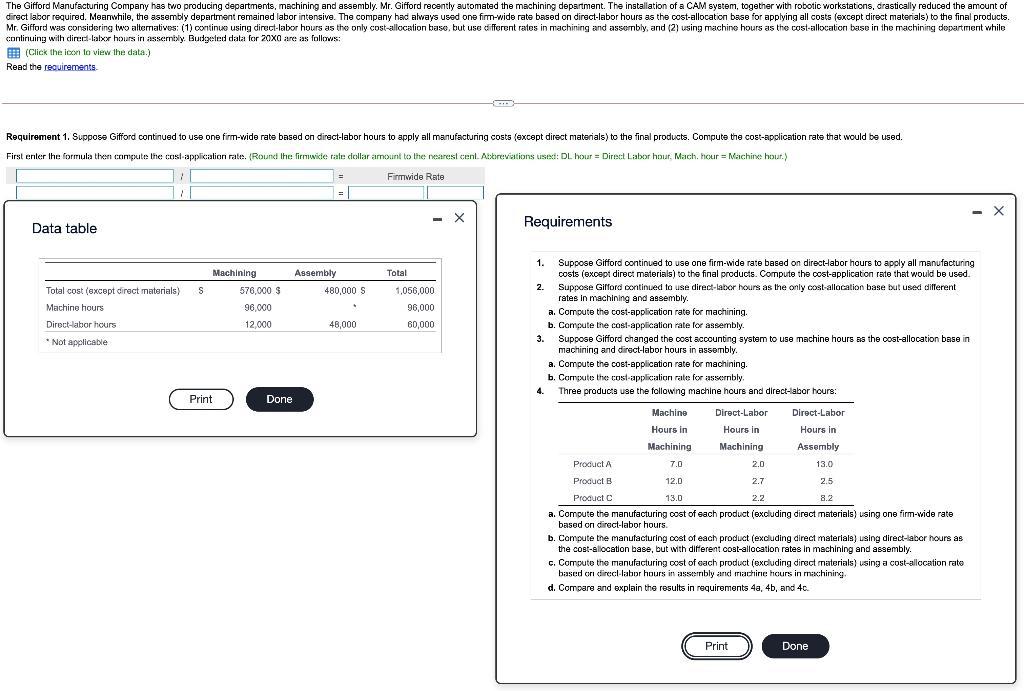Answered step by step
Verified Expert Solution
Question
1 Approved Answer
The Gifford Manufacturing Company has two producing departments, machining and assembly. Mr. Gifford recently automated the machining department. The installation of a CAM system,

The Gifford Manufacturing Company has two producing departments, machining and assembly. Mr. Gifford recently automated the machining department. The installation of a CAM system, together with robotic workstations, drastically reduced the amount of direct labor required. Meanwhile, the assembly department remained labor intensive. The company had always used one firm-wide rate based on direct-labor hours as the cost-allocation base for applying all costs (except direct materials) to the final products. Mr. Gifford was considering two alternatives: (1) continuo using direct-labor hours as the only cost-allocation base, but use different rates in machining and assembly, and (2) using machine hours as the cost-allocation base in the machining department while conlinuing with direcd-labor hours in assemily. Budgeled data for 20Xx0 are as follows: E (Click the icon lo view the data.) Read the requirements. Requirement 1. Suppose Gifford continued to use one firm-wide rate based on direct-labor hours to apply all manufacturing costs (except direct materials) to the final products. Compute the cost-application rate that would be used. First enter Ihe formula then compute the cosl-applicalion rate. (Round Ihe firmwide raale dollar amoint to the nearest cenl. Abreviations used: DL hour = Direct Labor hour. Mach. hour = Machine hour.) Firmwide Rate - X Requirements Data table 1. Suppose Gifford continued to use one firm-wide rate based on direct-labor hours to apply all manufacturing costs (except direct materials) to the final products. Compute the cost-application rate that would be used. Machining Assembly Total 2. Suppose Gifford continued to use direct-labor hours as the only cost-allocation base but used different rates in machining and assembly. Total cost (except direct materials) 576,000 $ 480,000 S 1,056,000. Machine hours 96,000 96,000 a. Compute the cost-application rate for machining. Direct-labor hours 12,000 48,000 60,000 b. Compute the cost-applicalion rate for assembly. 3. * Not applicable Suppose Gifford changed the cost accounting system to use machine hours as the cost-allocation base in machining and direct-labor hours in assembly. a. Compute the cost-application rate for machining. b. Compute the cost-application rate for assermbly. 4. Three products use the following machine hours and direct-labor hours: Print Done Machine Direct-Labor Direct-Labor Hours in Hours in Hours in Machining Machining Assembly Product A 7.0 2.0 13.0 Product B 12.0 2.7 2.5 Product C 13.0 2.2 8.2 a. Compute the manufacturing cost of sach product (excluding direct materials) using one firm-wide rate based on direct-labor hours. b. Compute the manutacturing cost of each product (excluding direct materials) using direct-labor hours as the cost-ellocation base, but with different cost-allocation rates in mechining and assembly. c. Compute the manufacturing cost of cach product (excdluding direct materials) using a cost-allocation rate based on direcl-labor hours in assermbly and machine hours in machining. d. Compare and explain the results in requirements 4a, 4b, and 4c. Print Done
Step by Step Solution
★★★★★
3.37 Rating (147 Votes )
There are 3 Steps involved in it
Step: 1
Step 1 of 10 A ActivityBased Costing ABC method Under ABC method costs are allocated based on the ac...
Get Instant Access to Expert-Tailored Solutions
See step-by-step solutions with expert insights and AI powered tools for academic success
Step: 2

Step: 3

Ace Your Homework with AI
Get the answers you need in no time with our AI-driven, step-by-step assistance
Get Started


